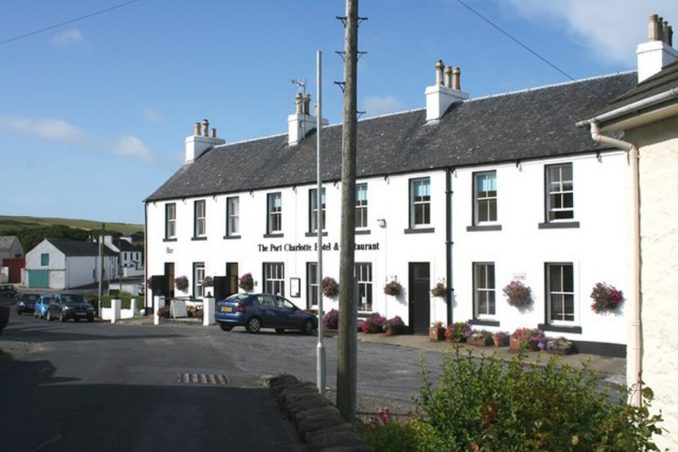
17.30 Saturday 31st October 2015
For the second day running, we sit on the hard plastic chairs at Glenegedale Airport, staring despondently out of the windows into the grey Islay gloom, with only the occasional whirr of the vending machine to break the silence. The plane didn’t make it yesterday: will it soldier through today?
My trusty Nokia breaks the silence, arousing the small gloomy group around us, with a text from my daughter-in-law, “Just boarded at Glasgow: as predicted, we sat on the ground at Campbeltown for over an hour.” Relief: it was happening: the short break, planned with military precision, would surely now go ahead.
Campaign Planning
Sometime in the summer of 2015, my husband announced that we were going to embark on a distillery tour of Islay later in the year to celebrate an important birthday for him in September and a milestone birthday for his elder son in October. Why he chose a distillery trip in Scotland, I will never know, he was much more of an Armagnac and Calvados drinker: but chosen he had, and years of experience had taught me that debating his choice was not a hill to die on.
The decision having been made, it was, as was the usual way, up to his second in command to organise the trip. This was more complex than it sounds. I had spent the summer the previous year in hospital courtesy of the French health system, having broken the head of my femur in sixteen places. To be fair, Tours University Hospital had preserved my femur, but only by attaching a huge 8” industrial plate, fixed with large bolts, which meant I was able to walk (painfully), but was totally incapable of climbing stairs. In an area where modern hotels with lifts were available, this would have been no problem, but it soon became apparent that Islay was not such a destination: all hotels could have been (and probably originally were) fishermen’s cottages, now linked together.
I compiled a list of half a dozen hotels which looked acceptable, and, at first base, struck lucky with the Port Charlotte Hotel, top of my list, which proved to have two ground floor rooms. My hopes were dashed when I ‘phoned and found that the rooms were already booked for our dates, but I had reckoned without the entrepreneurial spirit of the Port Charlotte. “Hang on”, the receptionist said, “I’ll phone Mrs H, and I’m sure she will be happy to go upstairs”. And so it proved. Relief: I had reached first base, and secured a hotel.
How We Travelled to Islay
The next task was to get the four of us to Islay. We decided that we would have to drive, and take the ferry, while my stepson and his partner would fly from Birmingham Airport the day after we arrived on a route which involved a transfer to Loganair at Glasgow Airport.
Booking the flight proved to be the easier option: Flybe had a published schedule and it was simplicity itself to click and book online (although, as we were to find out, fulfilling the booking was to prove somewhat more taxing – the pilot on the day of the flight decided to put his Twin Otter down at Campbeltown, on the Kintyre peninsula, where the passengers were put up for the night, and picked up again the next day for transfer back to Glasgow, to be flown once more to Islay!).

The ferry operator, Caledonian MacBrayne, was an entirely different issue. The company’s online site suggested that the dates and times shown were what they might probably be, given their likely change of timetable the day before our journey, and implied that they might be good enough to let us know before the date of our journey whether the particular ferry crossing we had booked would sail or not. It most emphatically did not inspire confidence, but I booked, and crossed my fingers – what else could I do?
All that remained was to research and book hotels en route to and from the ferry at Kennacraig on the Scottish mainland. I settled for a plastic hotel (with lifts) in Dumbarton on the outward journey and the Wateredge Hotel on the shores of Lake Windermere (with ground floor garden room annexes)| for the return journey.
What To Do on Islay
As always when researching, I turned to two sources of information, books and the Internet. I was fortunate enough to find a 1935 “Guide to Islay”, by L. Macneill Weir, MP for Clackmannan and East Stirlingshire (from 1935 to 1939). I always start with vintage books because they’re so much more interesting than modern ones, you can give them to appropriate people as presents, and, if not, you still have an enjoyable book to read after the holiday is over. Because I am also a practical person, I got hold of a copy of “Islay, Biography of an Island”, a weighty tome by Margaret Storrie.

The Internet revealed that there were countless organised distillery tours, but they were about as attractive as the prospect of a forced march with my bad leg: two distilleries in the morning, two more in the afternoon. No thanks: it was certainly not my intention to be worn out and inebriated before lunch, (or, for Yorkshire tourists, dinner)!
Instead, I decided to read up on the distilleries, and select the ones that looked the most interesting.
In addition to the distillery selection, my guide books and the Internet gave me recommendations on restaurants, which I duly noted, as well as places of historical and wildlife interest. My stepson is a keen golfer, but, as the rest of us were not, the Machrie golf course was quite firmly excluded from my list of things to do.
The Road Trip to Islay
Never one to rely exclusively on modern technology (especially when it has previously been found wanting), I had taken the precaution of printing out the Michelin route from Worcestershire to Dumbarton, and from Dumbarton to Kennacraig. Leaving home early on the Thursday morning, the first four hours on the familiar M5/M6 were relaxed enough, with nothing more to contend with than the usual roadworks on the M6.
And then we were in foreign parts. As navigator, it was obviously my fault when we found ourselves in the wrong lane as we approached the hotel in Dumbarton, after two more gruelling hours (when, to be fair, I had navigated Glasgow in the pouring rain). Switching seamlessly into the correct lane when I spotted my mistake, my husband cut across and badly upset a small fiery lady driver, who followed us into the hotel car park to remonstrate with him in what I can only describe as “colourful language”. I shrank back into my seat, hoping I was invisible: my husband was big enough to look after himself, and I sensed that my intervention would only inflame the lady further. Several abject apologies later, she was sufficiently mollified to go on her way. This was my first encounter with a Glaswegian on home territory, and one I shall never forget.
Next morning, we had the luxury of a more leisurely journey: the boat did not leave until 13.00 and the journey from Dumbarton to Kennacraig was shown as two hours. We were soon driving alongside Loch Lomond, and, while it was in an attractive wooded setting, I have to confess that I was somewhat disappointed that it wasn’t more “special”. It was a beautiful enough lake, but I just felt that a loch which featured in such a famous song, should have had more going for it.
Tarbert, at the head of Loch Fyne, bristling with sea food restaurants and a busy market, was a much more interesting prospect. I could have happily spent a few hours there, but, White Rabbit-like, I made myself turn my back on it (I couldn’t afford to make a second navigational mistake in two days). After Tarbert, I noticed little else of the surroundings, concentrating hard on my directions, as the route became one of those classic non-stop “turn left: turn right: sharp bends” affairs.
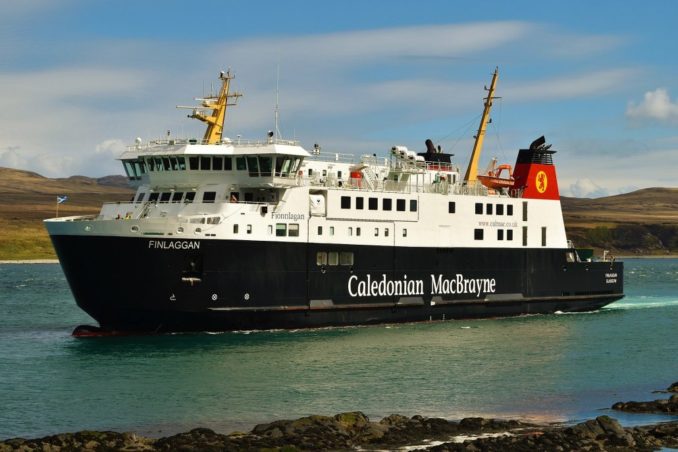
Mn28, CC BY-SA 4.0, via Wikimedia Commons
Caledonian MacBrayne
Carefully following my Michelin directions, I was somewhat surprised when we reached the turning for what was allegedly the “port”, so much so that I insisted my husband turn back and retrace our route in case we had missed the entrance to the “real” port. No other turning seemed to fit, so we ended back where we had started, staring at a line of cabins and trying to guess which one, if any, had an official purpose. I still had my fingers crossed that we would really get to our island destination.
I shouldn’t have worried. A helpful local or employee (I know not which) asked whether we needed any help, took us to the appropriate cabin, where we checked in, and then to what I assume was the bar, as drink was being enthusiastically consumed.
Eventually people drifted out of the bar: we followed: being totally ignorant of what happened next, we pursued a “when in Rome” strategy. It was just as well we did, as the moment of embarkation had arrived (without the formality of an announcement or any such fiddly detail). And, without any fuss, we were soon on the boat.
We joke about “Boaty McBoatface”, and I know about the Company’s interesting financial dealings, but I have to tell you, I loved that ferry. In all my years of taking ferries, it is only the second one that I have found any pleasure in travelling on (the first being P&O’s brief foray into fast ferries on the French Western Route).
The layout was simple: comfortable armchairs where we entered, restaurant/snack bar behind them. Err, that’s it. The restaurant was excellent. “Here’s the menu, but, if you want something else, we’ll make it for you, if we have the ingredients.” A calm sea, delightful scenery, good food, two hours of bliss.
All too soon, it was over, and we were en route to Port Charlotte.
I should perhaps explain the geography of Islay: better still, here’s a map.

As you can see, our drive took us from the ferry at Port Askaig (top right) to Bridgend at the top of Loch Indaal, and around the loch down to Port Charlotte on the left hand land mass.
Port Charlotte Hotel
At the end of our journey, we eventually arrived at the hotel. Using Sassenach logic, we followed the signs to the car park. Wrong! The car park was on the low road with steep steps up to the hotel, whereas the entrance was way above on the high road. Beating a hasty retreat, we retraced our steps and parked right in front of the hotel.
The minute I entered its portals, I knew that this was my kind of hotel. Over the years, I have stayed in the grandest of hotels, where I have felt lost in ballroom-sized restaurants; I have stayed in country pubs, many with paper walls or unsatisfactory plumbing; I have stayed in modern plastic hotels, where I can never find my room because every corridor looks the same: I have even stayed in a French station hotel with a bidet on wheels (but the food was tremendous)! In short, I know the kind of hotel I like: the Port Charlotte Hotel was definitely IT.
Our room was spacious, and airy, overlooking Loch Indaal; it may have had a little too much tartan for my taste, but, hey, it’s in a Scottish tourist area: what else do you expect? The room even boasted a broadband facility, which really did work (now and again!)
The centre of activity was the bar, renowned for its unequalled range of Islay malts. Opposite the bar was a roaring fire, and, to either side of it, small wooden refectory style tables on which was served the most delicious food. As a seafood glutton, I rarely got past the lobster, scallops and langoustines on the menu, although I did try the haggis, neaps and tatties one evening, which I thoroughly enjoyed, and subsequently served to friends on several occasions.
Music and singing (both organised and spontaneous) were the order of every evening, and, yes, I know some people hate it (I was with two of them!), and I myself am happy just to sit there and absorb the atmosphere, but my daughter-in-law, who views herself as Whitney Houston reincarnated, (unfortunately, without the voice), made sure that we were always in the middle of the “action”.
And for anyone who didn’t want to join in, there was the very pleasant, cosy, panelled restaurant, which is next to Reception. I know its location because one morning when I was sitting there waiting for the others, the side “wall” collapsed and a large gentleman almost fell into my lap, still clutching his toast.
Just one word to the incautious. I love my stepson dearly, but, if he does have one fault, he can, on occasions, prove gullible. One evening, the three of us decided to go to bed and made the mistake of leaving him at the bar with his new found friends. I will just say that the size of bar bill was “unexpected”: malts at £35+ a tot did not seem to be a rarity at the Port Charlotte Hotel Bar.
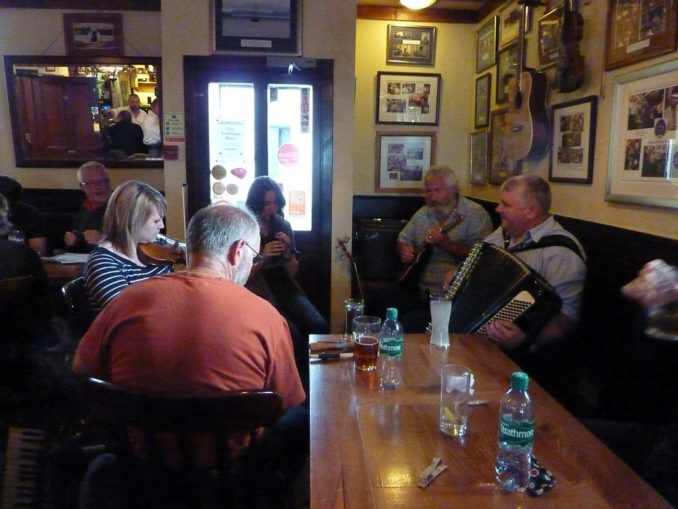
Back to the Whisky
I have been nattering on about our journey to Islay and our hotel, and must now turn to its original purpose – the distillery tour.
Cringe not, scientific readers, I am not about to insult your intelligence with a lyrical description of the distillation process. Just a few of my thoughts:-
*You’ve seen one, you’ve seen ‘em all: my distillery baptism was Calvados at Père Magloire,
*If you’re interested, there are now distilleries you can visit all over the UK.
*They’ll all tell you they are the only ones with ancient equipment: ignore it – it’s not true.
*They’ll also tell you the duty and taxes they have to pay support the rest of the economy (especially in Islay, where we Sassenachs apparently live off the fruit of their labour!)
*It’s such a simple process, I’ve even done it myself (obviously not in our own fair country!).
Islay distillers were already emphasising “territory” as the explanation of the special quality of Islay malts, by which they mean the barley, yeast, peat and water found on the island.
Bruichladdich
As luck would have it, there was a distillery just up the road from the hotel, so, quite naturally, we decided to make Bruichladdich our first port of call.
In common with all the other (at the time) seven historic distillers on Islay, Bruichladdich has had a chequered career. Founded by the Harvey brothers in the 1880s, its star waned on their death, until eventually it was purchased by Whyte & Mackay, and fell into disuse except as a storage unit, until, in 2000, Mark Reynier, a London wine merchant, formed a company to buy it out for £6m. Over the next 12 years, Mark built Bruichladdich into an international brand, selling it to Remy Cointreau for £58m, and moving on to a successful new venture in Waterford.
Again, I struck lucky in Islay with my visit to my first whisky distiller. It was, and remains, my favourite. As you approach the distillery, along the road beside Loch Indaal, you cannot miss the barrels painted in the distinctive Laddie blue across the front of the premises, which contrast with the enormous still and the whitewashed buildings behind.
The highlight of any tour is the tasting at the end, and, for those who are not familiar with Bruichladdich whisky, I would summarise the range as unpeated, (Laddie and most others) medium peated (Port Charlotte) and heavily peated (Octomore). Bruichladdich also produces the Botanist, a most palatable gin.
The distillery also boasts a shop, with some typical tat, but also with an impressive range of country clothing, and the most heavenly tartan. Now, I can take tartan, or leave it (usually the latter), and nothing would persuade me to wear a kilt (I would feel like one of those porcelain lady’s heads on top of a fussy cake), but this tartan is a gorgeous blend of blue and green (my favourite colours), and, if only I could think of something to do with it….
Ardbeg
My husband was not alone amongst Puffins in appreciating the nectar which is Ardbeg, and so a visit to the distillery was on my list. The Ardbeg Distillery is at Port Ellen, near the base of the right hand Islay land mass. Now owned by Glenmorangie, Ardbeg has had the same chequered past as the other Islay distilleries. Founded by farmers in the early Nineteenth Century, it fell silent in 1981, subsequently opening and closing with some regularity until it was acquired by Glenmorangie in 1997. In contrast with Bruichladdich, whose owners hardly seem to register with those working there, it is evident that Ardbeg is definitely under the control of its masters. (You can’t help overhearing conversations sometimes!)
It boasts most attractive whitewashed buildings with very distinctive rooves (like upside down egg cups, seen on a number of Islay distilleries). It is comparatively touristy, promoting its Old Kiln Café, which, if I am to be totally frank, is rather like eating in an aircraft hangar, although the food is reasonable enough. Unfortunately, there is a steep slope from its car park to the distillery, which did not endear it to me.
And the whisky (for those who don’t already know) is peated, (very peated, I would say), and thus, unfortunately, not my favourite. I am sure there are others on here who can give you a much more lyrical description of the taste.
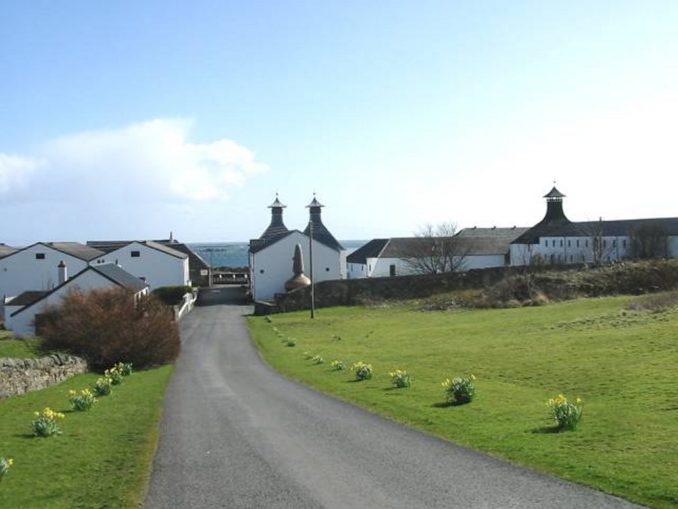
Kilchoman
The Kilchoman Distillery is located on the left hand land mass, NW of Port Charlotte almost on the opposite coast. Because it was the only recently established distiller on the island, set up from scratch in 2005 by Anthony Wills, my husband was keen to see it. My husband loved the back story and the whisky. He became a member of the Club, and purchased the Club Exclusive Limited Edition Whisky every subsequent year.
I was more dubious. I did not see the relevance of the highly priced crockery and cutlery filling the showroom (apart from making money, obviously), and I was not impressed by the superior attitude of the owner and his wife.
Having said this, there is nothing wrong with the range of whiskies as drinks: it’s just the manufactured cult status that I dislike.
The taste of all whiskies is significantly affected by the barrels they are stored in after distillation. Because of this, in general, second hand barrels are preferred (sherry, bourbon, Bordeaux etc.). Perhaps because of the youth of the distillery, Kilchoman makes a particular feature of this in its marketing, as well as the farm, where it grows its own barley.
Enough, I think, of distilleries. We did visit others, Bowmore certainly (I remember the capital of Islay with its steep main street with shops both sides dominated by the round Kilarrow Parish Church at the top), but nothing else particularly remains in my memory.
And Finally the Seals
Islay has a rich history, which I had planned to cover by visiting the museums, but, unfortunately, they were closed (yes, I had checked, and no, they weren’t supposed to be). This meant that, very unfortunately, I had to abandoned this aspect of my plan, as there was no way I was in any fit state to go yomping over the peat moors.
I was luckier with the wildlife, especially the seals. The puffins had already departed by November, but, as planned, we visited Portnahaven to see the seals. It is an interesting village, built in single file around the high cliffs at the very tip of the Left hand Islay land mass. I had never before seen seals in their native environment, and I could have watched them for hours, completely motionless (both the seals and I). The first time we went, there was the usual idiot who thought it a big joke to let his dog harass the seals, but they did not react too much, as, fortunately, the pups were all at the opposite side of the bay.
I had identified a pub for lunch, called “An Tigh Seinnse” (“House of Singing”, in Gaelic), and so I looked round for the pub sign – no joy. Carefully checking my directions, I tentatively opened a door to be greeted by a roaring fire in what looked like someone’s living room, (rather like the pubs you find in Southern Ireland). I need not have worried: we were welcomed warmly and the food was good. It became our go-to spot for lunch.
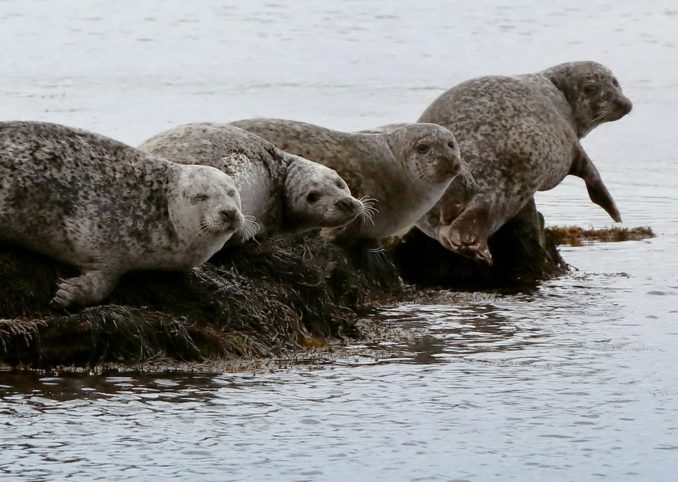
And there I will leave Islay, with the memory of the seals imprinted on my mind. We vowed to return, but life intervened, and we never did.
Epilogue
I was prompted to write this when I was tidying out my filing cupboard and came across a file entitled “Islay Trip”: I sat down to read it, and the memories came flooding back. A holiday which I had been dreading so much, (no-one likes to be a drag on others), had turned out to be more spectacularly enjoyable than I could ever have imagined.
Although the holiday had taken place six years before, I felt it might be of interest to readers who have not visited the island, especially those from south of the Border, who may be less knowledgeable about it than our Scottish brethren. Islay hadn’t changed very much in the eighty years between Mr Macneill Weir’s writing of his guide book and our visit (except that the ferry and flight options had reduced), and I doubt that Islay has, in essence, changed since we were there. I gather that the Machrie golf course hotel has been significantly updated, and that two more distilleries have opened: oh, and the Port Charlotte Hotel is now rated best on the island. But the puffins will still come every summer, the grey seals will still bask on the rocks at Portnahaven and the distilleries will still be selling their malts.
Much, of course, has happened in the meantime in the world outside Islay. Loved ones have died: babies have been born. Relationships have ended, and others been formed. We had our (as we thought) victory in the EU Referendum: we had the Remainer rear-guard action, and finally we had the Pandemic, since when life has never been the same.
It is for this reason that I have recorded a holiday which took place when we took life as it had always been for granted, and had not yet seen the rain clouds forming. It is in this light that I offer my personal memories of Islay to my readers, who will, as always, judge for themselves.
© Chrissie 2022



